Cassini ends 2004 with flyby of icy moon Iapetus
Dec 30:
NASA's Cassini spacecraft is set to cap off 2004 with an encounter of Saturn's
ying-yang moon Iapetus on New Year's Eve. Iapetus is a world of sharp contrasts.
The leading hemisphere is as dark as a freshly-tarred street, and the white,
trailing hemisphere resembles freshly-fallen snow.
 FULL STORY FULL STORY
 EARLIER IAPETUS IMAGERY EARLIER IAPETUS IMAGERY
 |  |
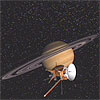
|
 |
Tethys' great rift
Dec 30:
This dazzling new view of Saturn's moon Tethys from the Cassini spacecraft shows
the tremendous rift called Ithaca Chasma, which is 60 miles wide in places, and
runs nearly three-quarters of the way around the icy moon.
 FULL STORY FULL STORY
 |  |

|
 |
Stars of wonder, stars of infrared and X-ray light
Dec 29:
This montage shows three clusters of bright, young stars in X-ray (blue) and
infrared (green) light that lie in the direction of the centre of the Galaxy.
Like many stars in the disk of the Galaxy, they are difficult, if not impossible,
to see with an optical telescope because of interstellar dust that blocks the
visible light.
 FULL STORY FULL STORY
 |  |

|
 |
Asteroid 2004 MN4 will miss
Earth in 2029
Dec 27:
One potential hammer blow from space can now be dismissed for the foreseeable future:
astronomers have just refined the orbit of near-Earth asteroid 2004 MN4 and
can state categorically that it will miss our planet on April 13th, 2029.
 FULL STORY FULL STORY
 |  |

|
 |
Jupiter's moon Amalthea was probably captured
Dec 24:
The first ground-based infrared spectrum of Jupiter's moon Amalthea reveals that it
must have formed far from its current location. This new result, based on observations
with the Subaru telescope and the NASA Infrared Telescope Facility, sheds new light
on our solar system's turbulent past.
 FULL STORY FULL STORY
 |  |

|
 |
Cassini orbiter deploys Titan descent probe
Dec 24:
In a long-awaited milestone, a European-built probe carrying cameras and a suite of
scientific instruments was released from NASA's Cassini Saturn orbiter Christmas Eve,
setting up a dramatic January 14th plunge into the atmosphere of the ringed planet's
mysterious moon Titan.
 FULL STORY FULL STORY
 DETAILED TIMELINE DETAILED TIMELINE
 |  |
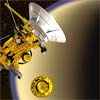
|
 |
World's most powerful infrared camera begins observations in Hawaii
Dec 22:
A new astronomical camera has begun operations on the United Kingdom Infrared Telescope
(UKIRT) in Hawaii. The Wide Field Camera (WFCAM) is the world's most powerful infrared
survey camera. It will survey large regions of the sky at infrared wavelengths and is
expected to discover both the nearest objects outside our solar system and the farthest
known objects in the universe.
 FULL STORY FULL STORY
 |  |
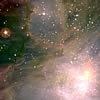
|
 |
Aging universe may still be spawning giant "baby" galaxies
Dec 21:
NASA's Galaxy Evolution Explorer has spotted what appear to be massive "baby" galaxies
in our corner of the universe. Previously, astronomers thought the universe's birth rate
had dramatically declined and only small galaxies were forming.
 FULL STORY FULL STORY
 |  |

|
 |
Saturn lightning, rotation discoveries made
Dec 20:
As NASA's Cassini spacecraft approached Saturn last July, it found evidence that
lightning on the planet is roughly one million times stronger than lightning
on Earth.
 FULL STORY FULL STORY
 |  |
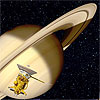
|
 |
New clouds add to mystery of Saturn's moon Titan
Dec
19:
Using adaptive optics on the Gemini North and Keck II telescopes on Mauna Kea,
Hawaii, a U.S. team has discovered a new phenomenon in the atmosphere of Saturn's
largest moon Titan. Unlike previous observations showing storms at the south
pole, these new images reveal atmospheric disturbances at Titan's temperate
mid latitudes — about halfway between
the equator and the poles.
 FULL STORY FULL STORY
 |  |
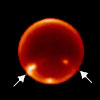
|
 |
Saturn's outer rings may be eroding, Cassini data shows
Dec
18:
A massive eruption of atomic oxygen from Saturn's outer rings, seen by Cassini's
ultraviolet camera as the spacecraft neared its destination, may be an indication
that the planet's wispy E ring is eroding so fast that it could disappear within
100 million years if not replenished.
 FULL STORY FULL STORY
 |  |
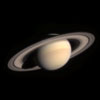
|
 |
Hubble puts a new twist on an old nebula
Dec
17:
Looks can be deceiving, especially when it comes to celestial objects like galaxies
and nebulae. These objects are so far away that astronomers cannot see their
three-dimensional structure. The colourful Helix Nebula is one good example.
 FULL STORY FULL STORY
 |  |

|
 |
Before and after look at Saturn's moon Titan
Dec 16:
Cassini's second close flyby of Titan completes a 'before' and 'after' look at the fuzzy
moon and provides the first direct evidence of changing weather patterns in the skies
over Titan.
 FULL STORY FULL STORY
 |  |
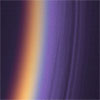
|
 |
Symphony of colours in the Tarantula Nebula
Dec 15:
The Tarantula Nebula is the most vigorous star forming region known in the local universe.
This amazing panorama was created by a young amateur astronomer from images captured by the
Hubble Space Telescope.
 FULL STORY FULL STORY
 |  |

|
 |
Earth's safe zone got hot during legendary storms
Dec 15:
A NASA-funded study found a region between radiation belts surrounding the Earth
is not as benign as once thought. The region was considered a safe zone for
satellites in "Middle Earth"
orbits, because of relatively small amounts of radiation.
 FULL STORY FULL STORY
 |  |

|
 |
Pulsar gives insight into ultra dense matter
Dec 15:
A long look at a young pulsar with NASA's Chandra X-ray Observatory revealed
unexpectedly rapid cooling, which suggests that it contains much denser matter
than previously expected. The pulsar's cool temperature and the vast magnetic
web of high-energy particles that surrounds it have implications for the theory
of nuclear matter and the origin of magnetic fields in cosmic objects.
 FULL STORY FULL STORY
 |  |

|
 |
Cassini has another successful Titan flyby
Dec 13:
The Cassini spacecraft completed a successful rendezvous with Saturn's moon Titan
on Monday, December 13th. This was the last pass before the European Space Agency's
Huygens probe is sprung loose from Cassini on Christmas Eve.
 FULL STORY FULL STORY
 CASSINI NEWS ARCHIVE CASSINI NEWS ARCHIVE
 |  |
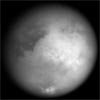
|
 |
From Saturn's dark side
Dec 11:
As Cassini swung around to the dark side of the planet during its first close
passage after orbit insertion, the intrepid spacecraft spied three ring moons — Mimas,
Janus and Prometheus — whizzing around the planet.
 FULL STORY FULL STORY
 |  |
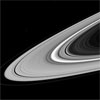
|
 |
'Solar ultrasound' waves discovered by satellite
Dec 10:
The Sun's atmosphere is filled with ultrasound-like waves that may help solve
decades-old mysteries about the Sun and space weather, according to Southwest
Research Institute scientists who found the waves in data from NASA's TRACE
spacecraft.
 FULL STORY FULL STORY
 |  |

|
 |
Spitzer, Hubble capture evolving planetary systems
Dec 9:
Two of NASA's Great Observatories, the Spitzer Space Telescope and the Hubble Space Telescope,
have provided astronomers an unprecedented look at dusty planetary debris around stars the
size of our Sun.
 FULL STORY FULL STORY
 |  |

|
 |
Report: Shuttle servicing of Hubble is best option
Dec 8:
To ensure continuation of the extraordinary scientific output of the Hubble Space Telescope
and to prepare for its eventual de-orbiting, NASA should send a space shuttle mission, not
a robotic one, says a new congressionally requested report from the National Academies'
National Research Council.
 FULL STORY FULL STORY
 |  |
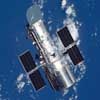
|
 |
Saturn's moon Iapetus as you've never seen it
Dec 8:
New details on Iapetus are illuminated by reflected light from Saturn in this revealing
Cassini image. Never-before-seen features on the Saturn-facing part of Iapetus' bright
trailing hemisphere are visible for the first time.
 FULL STORY FULL STORY
 CASSINI NEWS ARCHIVE CASSINI NEWS ARCHIVE
 |  |
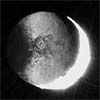
|
 |
Explosions in majestic spiral galaxy beauties
Dec 5:
Images of beautiful galaxies, and in particular of spiral brethren of our own Milky Way,
leaves no one unmoved. It is difficult indeed to resist the charm of these impressive
grand structures.
 FULL STORY FULL STORY
 |  |

|
 |
Cassini captures Saturn moon red-handed
Dec 4:
Stealing is a crime on Earth, but at Saturn, apparently it is routine. The Cassini
spacecraft has witnessed Saturn's moon Prometheus snatching particles from one of
Saturn's rings.
 FULL STORY FULL STORY
 |  |
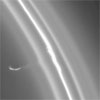
|
 |
Did our Sun capture
alien worlds?
Dec 1:
Computer simulations show a close encounter with a passing star about 4 billion years
ago may have given our solar system its abrupt edge and put small, alien worlds into
distant orbits around our sun.
 FULL STORY FULL STORY
 |  |

|
 |
Gazing down on Saturn
Dec 1:
The Cassini spacecraft pierced the ring plane and rounded Saturn a few weeks
ago, capturing these pictures that NASA has released showing the dark portion
of the planet's majestic rings.
 FULL STORY FULL STORY
 |  |
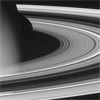
|
 |
A baby galaxy uncovered in a grown-up universe
Dec 1:
Using the Hubble Space Telescope, a scientist has identified what may be the
youngest galaxy ever seen in the universe. By cosmological standards it is a
mere toddler. Called I Zwicky 18, it may be as young as 500 million years old.
Comparatively, our Milky Way galaxy is about 12 billion years old, the typical
age of galaxies across the universe.
 FULL STORY FULL STORY
 |  |

|
 |



